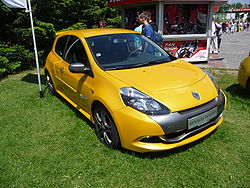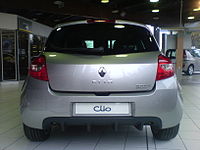- Renault Clio Renault Sport
-
Renault Clio Renault Sport 
Manufacturer Renault Sport Also called Renault Clio RS
Renault Clio RS 172/182/197/200Production 1998–present Class Hot hatch Body style 3-door hatchback Engine 2.0 L I4 petrol Transmission 6-speed manual Length 3,810 mm (150.0 in) (Mk II), 3,970 mm (156.3 in) (Mk III) Width 1,810 mm (71.3 in) (Mk II) Height 1,410 mm (55.5 in) (Mk II) Curb weight 1,050 kg (2,315 lb)-1,150 kg (2,535 lb) Related Renault Clio Designer Patrick le Quément The Renault Clio Renault Sport or Clio RS is a hot hatch produced since 1999 by Renault Sport, the high-performance division of French automaker Renault. It is based on the Clio supermini.
The engine has remained the same since the first Clio RS, a 2.0-litre straight-4 petrol engine, with an FF layout and a three-door hatchback body style.
Contents
Clio II RS (172)
The first Clio RS followed as the third Clio from Renaultsport division after the Clio 16V and Clio Williams. Renault presented the Clio RS in 1999. They used the body of the original Clio II from 1998 and added sportive features such as wider arches, different bumpers, side skirts and 15 inch OZ alloy wheels. it was powered by the F4R730 engine, a 2.0 litre 16valve with a VVT system via a dephaser on the intake camshaft pulley. The engine was not an evolution of the Williams one, called F7R. Instead, it was a new engine used in other Renault models, like the Laguna or the Espace, but optimized by mecachrome, with an output of 169 PS (124 kW; 167 hp).
A limited edition model called the Clio 172 Exclusive was produced and was limited to 172 units. All models were green, had BBS alloy wheels and featured a full leather interior as opposed to half leather and alcantara.
The interior and exterior of the Clio II were facelifted in 2001, and the Clio RS followed shortly after. Engine wise, the accelerator throttle was changed for an electronic one, minor design revisions were made to the cylinder head, it received a new airbox and filter, a cheaper and poor designed one, and instead of having 2 catalytic converters (like phase 1 had), it only has one larger with 2 Lambda sonds. These changes with the addition of some weight made this a little slower in comparison with Phase 1. The gear ratios were changed for a more closed ones to mend this. The exterior adopted the new design in the bumpers and lights.
The equipment included automatic xenon headlights with washers, six-disc changer, four airbags, revised leather seats (with a "Renaultsport" logo) and 16-inch (410 mm) alloy wheels.
In 2002 Renault Released the 172 Cup which bore the chassis code CB1N and was known by Renault as the "Sport lightweight version" The vast majority of cars were produced in Mondial Blue (metallic) with a handful of the cars being Iceburg Silver (Metallic). The 172 Cup did not have many of the luxuries of the regular 172 such as Leather/Alcantara Seats, Automatic Xenon Headlights, Rain sensitive wipers or solar reflective coated windscreen. However it did boast lightweight 16 inch Speedline Turini Alloy wheels and a ABS plastic front splitter to increase downforce and a restyled rear spoiler. The interior also had the usual silver plastic trims painted body coloured blue. The car had significant weight reduction with much of the sound deadening being removed and apparently thinner glass to reduce weight even further. Early models had no air conditioning and thus no climate control and typically produce more power as the engine has less ancillaries to drive, there is also a significant weight saving. However on a handful of the later cars, air conditioning and digital climate control was fitted. It is regarded by enthusiasts as a more hardcore hot hatch as it had no ABS brakes and also had revised suspension geometry in order to increase steering response which gives the car a tendency to oversteer. The brake bias is fixed by means of disconnecting the rear axle compensator, which typically fails a UK MOT test for low braking effort on the rear wheels.
Clio II RS (182)
In 2004, the Clio II was refreshed again. The black headlights were now grey, new 8 spoke wheels and more colour options were added (as well as some deleted), but the basic design stayed the same. The six-disc changer was dropped from the standard equipment but was still available as an optional extra. Cruise control and ESP (Electronic Stability Program) were now standard equipment.
The Clio RS changed a lot more than the regular Clio. The engine was upgraded to 178 PS (131 kW; 176 hp) with the addition of a twin exit exhaust tail pipes, a 4-2-1 manifold and a high flow 200 cell sports catalytic converter. The spare wheel was removed and replaced with a flat floor in the boot compartment to accommodate the new exhaust tailpipes. The interior received minor revisions with the perforated texture of the alcantara on the seats now having white dots and Recaro Trendline reclining bucket seats being available as a £800 optional extra in Cup models and a £500 optional extra in regular 182 models.
A new option that appeared was the Extreme/Cup add-on pack which included a ABS plastic front splitter, a restyled spoiler (the same one Renault fitted to the 172 Cup) and a strengthened hub with 60mm spacing on the strut bot holes (previously 54mm), lowered suspension and revised damper rates, a thicker/stiffer front anti roll bar and anthracite alloy wheels, which were rumoured to be lighter however they were in fact the same wheels which had two part numbers stamped on the back (one for silver and one for anthracite).
Clio II RS models could now be ordered in "Cup" specification which restricted the choice of colour to just two colours, J45 Racing Blue and Inferno Orange but meant the Extreme/Cup add-on pack came as standard. Cup models also lacked: Xenon headlights and headlamp washer jets, Climate Control (heater vents for rear footwells also removed) , illuminated sun visors, Solar Reflective Windscreen, Automatic headlights and rain sensitive wipers, leather / alcantara seats/door cards (rear bench also downgraded to a single piece item with no headrests), Engine cover, Sill plates with "Renault Sport" logos and Steering Wheel was downgraded to an item with no Renault Sport logo or rubber thumb grips. The carpet and headlining was also downgraded to a basic specification (even the document wallet was downgraded from faux leather to cloth). Sound deadening was also reduced, along with several fabric deflector pads present in the front wheelarch/engine bay gaps and one in the left rear wheel arch being removed from specification. The horn was downgraded from a twin unit to a single unit and the interior light was downgraded to a unit with no map reading function.
The rarest option seems to be the factory fitted Carminat Sat-Nav, probably due to the high cost and rumoured poor performance in comparison to aftermarket units.
However, the final Clio II RS ("Trophy" - of which 550 were made worldwide) were based on Cup models and included suspension revisions such as Sachs remote-reservoir dampers and eibach springs on the front (which lowered front ride height by 10mm) and revised dampers on the rear, lightweight Speedline Turini 16" Anthracite wheels, spoiler from the Clio 255 V6, RecaroTrendline seats and exclusive Capsicum red paint with Trophy decals on the sills and an individually numbered plaque on the driver's seat base. 500 went to the UK, while a further 50 (with subtle differences) went to Switzerland. The Trophy has been heralded as one of the best hot hatches of all time and won 'Evo' magazine's People's Performance Car of The Year, 2005, beating rivals such as the Lamborghini Gallardo and other exotica in the process.
Clio III RS (197)
The new Clio III drew technology from Formula One, including a rear diffuser and brake cooling side vents, they upgraded the engine, now to 194 bhp (145 kW; 197 PS). The car is heavier than its predecessor, but the acceleration figures are slightly improved due to a combination of more power, torque and the new six-speed gearbox with shorter gearing according to the official figures published on the Renaultsport website www.renaultsport.co.uk.
Clio III RS (200)
The facelifted Clio III is further enhanced with the inclusion of a Formula One style front splitter and the engine now produces 197 bhp (147 kW; 200 PS). This has been made possible by tweaks to the exhaust system, valve timing and ECU also stated to give a slight increase in fuel economy. Acceleration figures are expected to be slightly improved due to shorter gearing in 1, 2 and 3 and enhancements have been made to the cup chassis including making the steering rack more responsive. Cosmetic enhancements include the addition of larger tailpipes protruding slightly from the rear diffuser, i.d. coloured front bumper insert, wing mirror covers and rear diffuser and i.d. interior trim. Renault are also introducing a new i.d. paint option of Alien Green.
RS Clio Performance Comparison (Official Figures) Model Displacement Power Top speed 0-100 km/h Power/Weight 172 1998 cc 169 PS (124 kW; 167 bhp) 139 mph (224 km/h) 7.3 sec 160.38 bhp/tonne 182 1998 cc 178 PS (131 kW; 176 bhp) 139 mph (224 km/h) 7.1 sec 161.46 bhp/tonne 197 1998 cc 197 PS (145 kW; 194 bhp) 134 mph (216 km/h) 6.9 sec 158.88 bhp/tonne 200 1998 cc 200 PS (147 kW; 197 bhp) 141 mph (227 km/h) 6.9 sec 161.34 bhp/tonne 200 Cup features a stiffer and lighter chassis, quicker steering and a lower ride height and has a lower equipment level than the standard Clio Renaultsport 200.[1]
See also
References
- ^ "2009 Geneva Auto Show: Renaultsport Clio 200 and Mégane 250". Edmunds.com. 2009-03-03. http://www.edmunds.com/insideline/autoshows/geneva/2009/renaultsportclio200andmegane250news.html. Retrieved 2010-11-07.
External links
- RenaultSport- UK Official website
- Clio197.net - Clio 197 owners club
- cliosport.net - UK based enthusiasts club
- Renaultcentre.com - Renault New & Used Parts
- OzRenaultSport.com - Community of Australian Renault Sport enthusiasts
Renault S.A. Current: Numeric: 1970–2009: 1945–1970: Between wars: Celtaquatre • Monaquatre • Juvaquatre • Monasix • Nervastella • NN • Novaquatre • Primaquatre • Reinastella • Viva Grand Sport • Vivaquatre • Vivasix • Vivastella •Type MTPre-WWI: 10CV • 12CV • 35CV • 40CV • L/M • N(a)/N(b)/S • N(c)/Q/U(a/e) • R/T • U • AS/V • Taxi de la Marne • Towncar • Voiturette • X/X-1 • YAlpine: Renault Sport: Grand Prix de l'A.C.F. • 5 Turbo • Clio Williams • Clio Renault Sport • Spider • Mégane Renault Sport • Clio V6 Renault SportConcept vehicles: Alpine 210 RS • Altica • Argos • Be Bop • BRV • Captur • DeZir • Ellypse • Espace F1 • EPURE • Evado • EVE • Egeus • Etoile Filante • Fiftie • Fluence • Frendzy • Initiale • Koleos • Laguna • Mégane • Nepta • Next • Ondelios • Racoon • R-Space • Sand'up • Scénic • Steppe • Talisman • Twizy Z.E. • VESTA 2 • Wind • Z.E. Concept • Zo • Zoe • ZoomVans and trucks: Dacia (current): Dacia (2000–2006): Renault Samsung: Formula One: See also: AvtoVAZ (25%) • Renault-Nissan Alliance
 Category ·
Category ·  CommonsCategories:
CommonsCategories:- Renault vehicles
- Sport compact cars
- Front wheel drive sports cars
- 1990s automobiles
- 2000s automobiles
- Vehicles introduced in 1999
Wikimedia Foundation. 2010.


